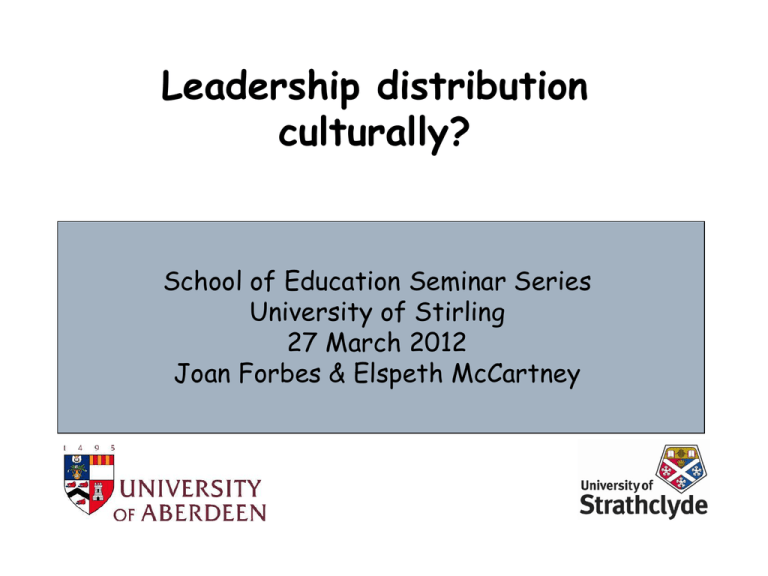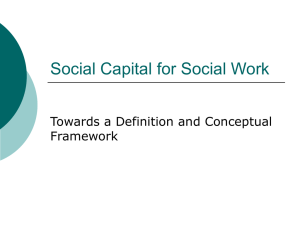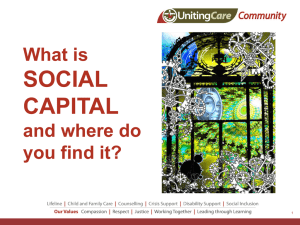Presentation available here - Propel
advertisement

Leadership distribution culturally? School of Education Seminar Series University of Stirling 27 March 2012 Joan Forbes & Elspeth McCartney Focus of the paper Education/Speech and Language Therapist social capital when working together in schools and children’s services The operation of professional networks, norms and trust for leadership in inter/professional relationships Paper is part of a wider research project into copractice relations in children’s services. The current policy agenda Scotland - Getting it Right for Every Child (SE, 2005) USA – No child Left Behind Act (2001) England – Every Child Matters agenda (DfES, 2004) NI- Extended Schools initiative (DE, NI, 2005) Wales – A Fair Future for Our Children (WAG, 2005) Eire – Giving Children an Even Break (DoES, IE, 2001) HMIe (2009) Improving Scottish Education Identifies issues to be addressed in child service partnerships Individuals, establishments and services cannot on their own deliver what is required in today’s demanding context. Priorities are: Strengthening partnerships across sectors and services [towards]…a unified learning and support system… Ensuring that education plays its full part in taking forward the GiRFEC approach,…the behaviours which will sustain effective partnership working Research now needed into ‘not fully successful interprofessional ties’ (HMIe, 2009) Interprofessional ties – practitioners’ social capital Micro level- of individuals’ different knowledges & skills Subject disciplinary and practice specific knowledges with which practitioners identify Rethinking micro level knowledge bases and meso-level practices within shifts in macro level policy & governance aimed to re-design children’s services SLTs in Education: (mainly) Dualsector/ - professional Policies Her Majesty’s Inspectorate (1996) The Education of Pupils with Language and Communication Disorders Scottish Office (1998) New Community Schools: The Prospectus Her Majesty’s Inspectorate of Education (2004)The Sum of its Parts? The Development of Integrated Community Schools in Scotland SE (2005a) Getting it Right for Every Child: Proposals for Action SG (2008) The Guide to Getting it Right for Every Child SLTs in Education: (mainly) Monosector/ -professional Policies Health Professions Council (2003) Standards of Proficiency SLTs: 1b2 RCSLT (2005) Clinical Guidelines SE (2005b) Delivery through Leadership: NHS Scotland Leadership Development Framework General Teaching Council Scotland (2006) Standard for Registration Element 2.1.5 SG (2007) Better Health, Better Care Action Plan Section 3 SG (2010) Guidance on Partnership Working between AHPs and Education What does social capital theory add? A move from ‘market’ discourses Re-inserting concern with the ‘social’ into policy Questioning underlying norms, networks and trust Transdisciplinary theory and analytics for transdisciplinary issues in services A theory that grasps the materiality of relations and disjunctures in policy, practice & professional knowledges & skills Key social capital concepts Potential of social capital for creation of networks, norms and trust, which can overcome disadvantage (Coleman; 1994; Putnam, 1996, 2000). ‘Networks, norms and trust & bonding, bridging & linking connections contribute to the accumulation of social capital. Key ideas in social capital BONDING SOCIAL CAPITAL- strong bonds can help people ‘get by’ but may also be limiting BRIDGING SOCIAL CAPITAL- builds relationships with a wider, more varied set of people: good for ‘getting on’ LINKING SOCIAL CAPITAL – connects people in different power/status positions in hierarchies Key terms in SC: Networks, norms, trust and reciprocity An analytical framework to take account of practitioners’ social capital relations Bonding – strong work relations with/within own home agency & subject discipline (e.g. linguistics) Bridging – good inter-practitioner, inter-agency work relations underpinned by appropriate mixes of human capital (qualifications, knowledge & skills) Linking – good work relations across institutions’ hierarchies underpinned by transprofessional structures & forums to institute & support change towards integrated services Bonding Bridging Linking MACROLEVEL: Exclusive confidence in home agency governance Trans-agency trust underpinned by policy Crossagency policy linked by trust National level: interagency governance and policy level Cross-agency policy linked/ characterized by relations of trust Inter-agency ties in service level agreements Children’s services links governed by users’ values Privileging single home agency or disciplinary group policy networks Ties across agencies’ governance & policy networks Governance & policy networks linking agencies’ hierarchies Trust/ Sanctions Norms Networks MESO: LEVEL Bonding Bridging Linking Strong/excl usive recognition of home professional trust & confidence Confidence & regard in practices of other professionals – or not Professional hierarchies respect & link to other professionals practice - or not Exclusive Practice Links to other Practice level: norms & connections professionals intervalues in to other hierarchies’ professional professionals professionals practice’ norms level in education & norms & children’s in practice values services sites Privileging Practice Practice links & home connections networks at profession/ to networks & professionals. site practice sites of other & service levels networks professionals Trust/ Sanctions Norms Networks MICROLEVEL: Bonding Bridging Linking Exclusive home profession confidence and regard Trust and support of other professions Supporting and supported by other profession’s leaders Exclusive Connected to Knowledge links Knowledge and bonds to other to other skills/ norms and professions professions’ individual norms and less/more practitioner values of own profession values powerful level Strong/privil eged monoprofession knowledge networks Knowledge ties to networks in/of other professions Links to skills of other professions’ leaders and hierarchies Trust/ Sanctions Norms Networks How do children’s services policy constitute leadership? Leadership seen as a principal mechanism to implement co-professional working: positional and distributed leadership. GiRFEC positional leaders: ‘named person’, ensuring a child has the right help, usually school manager ‘lead professional’, coordinating multi-agency planning, appointed ‘ad hoc’. Guidance on Partnership Working AHPs/Education: positional leaders in organisations should create ‘a context and an ethos in which staff can work together well’. How do children’s services policy constitute leadership? Cont’d. Distributed leadership: ‘recognising each others’ leadership role rather than relying on job titles and positions of authority’ (p42). ‘leadership is about focusing all activities on delivering an effective service to young people’ (p42). Very broad definition: cf. Peck and Dickinson (2008 p. 23) ‘what the government considers effective leadership starts to look suspiciously like smart followership’. How do children’s services policy constitute leadership? Cont’d. Such conceptualisations of distributed leadership are so wide they could include almost all co-working activities. What constitutes good distributed leadership remains underspecified. Social capital analysis Is practitioner leadership bonding in nature, privileging strong mono-professional knowledge base networks? Is practitioner leadership bridging in nature, with knowledge ties forged to the knowledge and skills networks of other professions in other subject disciplines? Is practitioner leadership linking in nature, with necessary links forged at appropriate levels in other agencies’ hierarchies/ professional organisations? Social capital analysis cont’d. Mono-professional policies sustain monoprofessional practices: supporting (limiting) monoprofessional knowledge base networks and social capital bonds. Mono-professional pre- and in-service training supports (limiting) mono-professional knowledge base networks and social capital bonds (and see Forbes & McCartney 2011). Social capital analysis cont’d. Some change initiatives such as GiRFEC’s opt-in learning community should sustain bridging leadership, with knowledge ties forged to the knowledge and skills networks of other professions. Such bridging social capital relations should support innovatory approaches to supporting children in schools by fostering change across and between networks (Clark 2007). Social capital analysis cont’d. However, teacher/SLT relationships are brief, bridging between strongly intra-professionally bonded networks of health and education (and see Forbes & McCartney 2012), so bridging ties will remain weak. Nonetheless, backed by policy enjoinders, weak bridging ties may go a long way to providing better services for individual children in their school settings. Social capital analysis cont’d. GiRFEC implementation procedures and Guidance on Partnership Working AHPs/Education frameworks and templates offer opportunities for positional leaders to develop and formalise links at appropriate levels with ‘other profession’ practitioners. Conclusions Policy rhetoric supports inter-agency links and distributed leadership. The roles of and training for mono-professional leaders remain more extensively specified in governance and legislation. Current practices reinforce weak bridging and linking relationships. Conclusions cont’d. But to effect the culture change sought across the policy and practice terrain of children’s services re-distribution of leadership culturally (MacBeath 2009) would be timely, that is practising leadership as a reflection of services’ real culture, ethos and traditions of co-working. Conclusions cont’d. Further, to better identify and understand current knowledge/s and skills for more suitable forms of leadership in the re-design of children’s services, an integrated and coherent programme of research into children’s sector practitioner education through the career lifecourse – including leadership roles – is now needed, drawing on potentially fruitful social-spatial relational analytics such as those of social capital. Reference Forbes, J. & McCartney, E. Leadership distribution culturally? Education/Speech and Language Therapist social capital in schools and children’s services, International Journal of Leadership in Education: Theory & Practice. First published online 31 August 2011. Additional Papers Forbes, J. & McCartney, E. (2010) Social capital theory: a cross-cutting analytic for teacher/therapist work in integrating children’s services. Child Language Teaching and Therapy, 26.3, 321-334 Forbes, J. & McCartney, E. (2011) Educating Scotland’s future together? Inter/professional preparation for schools and children’s services. Scottish Educational Review, 43 (2), 39-54 Forbes, J. & McCartney, E. (2012) Changing children’s services: a social capital analyses. In M. Hill, G. Head, A. Lockyer, B. Reid & R.Taylor (Eds.) Children’s Services: Working Together. Harlow: Pearson. Contact details Joan Forbes: j.c.forbes@abdn.ac.uk Elspeth McCartney: e.mccartney@strath.ac.uk







